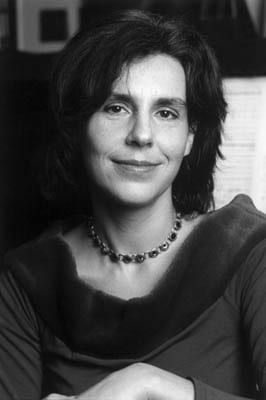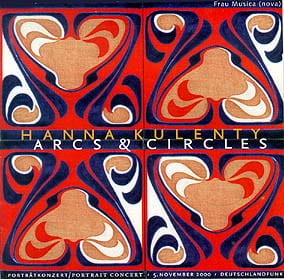b. 18 March 1961, Białystok
Biography

Hanna Kulenty began her music education studying piano at the Bacewicz Elementary Music School in Warsaw. Between 1980 and 1986 she studied composition with Włodzimierz Kotoński at the Chopin Academy of Music in Warsaw. From 1986-1988 she did her postgraduate work in composition with Louis Andriessen at the Royal Conservatory of Music in The Hague. She participated in the International Courses for Young Composers organized by the Polish Section of the ISCM and the International Summer Courses of New Music at Darmstadt. In 1985 her composition for orchestra, Ad Unum, received Second Prize at the European Young Composers’ Competition, organized in Amsterdam by the European Cultural Foundation to celebrate the continent’s unity. The theme of her work, a dissonant, dramatic and well-crafted study of convergence towards musical unity, was eminently suitable for this occasion. The same piece by the 24-year old composer, performed at the Warsaw Autumn Festival, elicited an enthusiastic response from Jan Weber, a very powerful music critic, who warned Kulenty’s male colleagues: “Gentlemen, hear and tremble!”
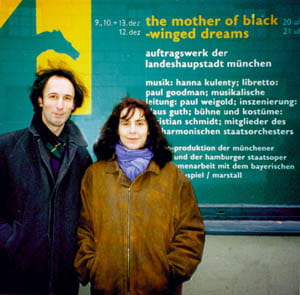
Hanna Kulenty received numerous awards and commissions, including the DAAD scholarship to Berlin, Germany (for senior artists in many disciplines), as well as composition commissions and scholarships from the governments of Poland and Holland. Ms. Kulenty has taught composition at courses and seminars in several European countries; her music has been featured at festivals in Poland, Denmark, England, Germany and Holland. Her music is currently available on three CDs and has been broadcast and recorded across Europe. In December 1996, the Hamburg Opera premiered her Mother of Black-Winged Dreams at the Munich Biennale. The opera explores the difficult subject matter of multiple personality syndrome and touches upon issues of suffering, child abuse, and gender relations. With the libretto by Paul Goodman, a Canadian writer who lives in Holland, this chamber work is structured as one long arch of increasing tension, spanning the duration of the piece.
Kulenty’s compositional style has evolved during the years. Her earlier music, consisting of many layers of simultaneous “arcs” which begin at different points of their emotional trajectories and proceed at different speeds, often calls for vast instrumental resources (two symphonies, Piano Concerto, Violin Concerto). With the richest sound palette, her preferred medium has been the symphony orchestra, but Kulenty has also written numerous chamber works. Commentators have often compared her orchestral style to Penderecki or Xenakis; she shares their flair for drama, expressive intensity, and relentless, layered rhythms. Formidable technical difficulties make One by One for solo marimba a showpiece of instrumental virtuosity. This work was composed in 1988 and premiered at the Pascal Zavaro Festival, Paris, Radio France, in January 1991. Another solo work, Still Life with a Cello was commissioned by the Schleswig-Holstein Festival in Germany, composed in 1993 and premiered at the Festival by Polish cellist, Andrzej Bauer. It is a counterpart to the earlier Still Life with a Violin composed for Krzysztof Bakowski. Both works share a rhapsodic playfulness with time, and a selectiveness of pitch material, though the cello composition is somewhat more repetitive, with more regular rhythmic patterns.

The subsequent turn towards minimalism in Kulenty’s works may be attributed to studying with Andriessen. Kulenty calls this phase of her oeuvre “European trance music” and often structures her compositions as single, powerful arcs. Good examples of this style include A Fourth Circle for violin and piano (1994) and A Sixth Circle for trumpet and piano (1995). The melodic instrument in A Fourth Circle could be a violin, viola or cello; the work is most frequently performed in the violin version. It was premiered at the New Music Festival, Musikhost, in Odense, Denmark, in 1994; the main theme of the festival was, “Three Polish Women: Bacewicz, Moszumańska-Nazar, and Kulenty.” A Sixth Circle for trumpet and piano, shares the melodic traits with its predecessor: microtonal inflections and long stretches of held notes in the trumpet, driving ostinati in the piano. Kulenty credits her intuition and the subconscious as the sources for the haunting sonorities and compelling emotional intensity of the music she creates. Whatever the explanation, the result certainly deserves our attention.
Education:
1976-1980 Szymanowski High School of Music, Warsaw (diploma in piano performance)
1980-1986 Chopin Academy of Music in Warsaw, M.A. in composition, studies with Włodzimierz Kotoński
1986-1988 Royal Conservatory of Music, The Hague, Holland, postgraduate studies in composition with Louis Andriessen
1983-1990 Participant in the International Courses for Young Composers, organized by the
ISCM (Polish Section) in Kazimierz Dolny, Poland
1984, 1988 Participant in the International Courses of New Music in Darmstadt, Germany
Appointments:
Spring 1992: Lecturer at the Chopin Academy of Music in Warsaw
May 1995: Lecturer at the First International Courses for Young Composers in Apeldoorn,
Holland, organized by the Gaudeamus Foundation
1996 and 2000: Lecturer at the International Courses for Young Composers, organized
by the ISCM (Polish Section) in Radziejowice, Poland
2001: Lecturer at the Seventh International Courses for Young Composers in Apeldoor, Holland, organized by the Gaudeamus Foundation
Guest Lectures:
1989 Sender Freies, Berlin, Germany
1989 Conservatory of Music, Rotterdam, Holland
1990 Academy of Music, Warsaw , Poland
1990, 1992 Conservatory of Music, Arnhem, Holland
1993 York University, England
1994 Odense and Kopenhagen, Denmark
1994, 1996 Munich Biennale, Munich, Germany
1998 Long Beach, USCB Santa Barbara, USC, Los Angeles, USA
1998 Conservatory of Music, Munster, Germany
2001 Conservatory of Music, Budapest, Hungary
2002 Bavarian State Oper, Munich, Germany
2002 Music Sacrum, Arnhem, Holland
2002 Conservatory of Music, Łódz, Poland
2003 Conservatory of Music, Amsterdam, Holland
Jury Memberships:
1992 Member of the National Jury for the World Music Days of the ISCM (ISCM, Polish
Section, Warsaw)
1994 Member of the Jury at the Munich Biennale (Opera Competition)
2002 Member of the Jury at the International Gaudeamus Music Week
2003 Member of the Jury at the Serocki Competition, Warsaw, Poland
Fellowships:
1990-1991 Deutscher Akademischer Austauschdienst (DAAD), Berliner Kunstlerprogramm
1993, 1994, 1995, 1996, 1997, 1998, 1999, 2000, 2001, 2002, 2003 Grants from Fonds voor de Scheppende Toonkunst, Holland
Hanna Kulenty’s works are published by Donemus and PWM.
Selected Compositions
For a detailed List of Works, click here.
For Discography, click here.
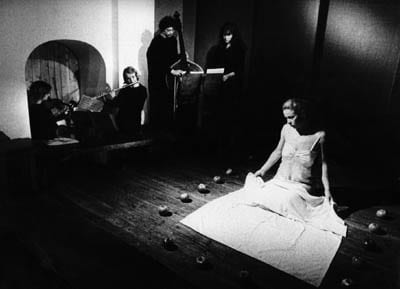
Stage Works
Przypowieść o ziarnie [Parable of the Grain], monodrama to texts from Three Women by Sylvia Platt (in Polish), composed in 1985 and premiered at a 1985 PTMW Concert in Piwnica na Wojtowskiej, Warsaw
The Mother of Black-Winged Dreams, opera in one act (1995). Libretto in English by Paul Goodman. Premiere at the Munich Biennale 1996, dir. Claus Guth
Hoffmanniana, opera in two acts (2002). Libretto in German by Erik Aufderheyde
Works for Orchestra and Large Ensembles
Ad unum for symphony orchestra (1985), premiered by N.O.S. Radio Orkest Hilversum, cond. David Porcelijn, Groningen, September 1985
A few minutes for Ereprijs for chamber ensemble (1992), premiered in April 1992 by De Ereprijs, Arnhem
Air for chamber ensemble (1991), premiered by De Volharding, Amsterdam
Breathe for string orchestra (1987), recorded by Amadeus Orchestra, cond. Agnieszka Duczmal, Poznań
Going Up 2 for chamber ensemble (1995), premiered at the 1995 Warsaw Autumn by De Ereprijs
Part One first part of the 3rd Symphony for symphony orchestra (1998), premiered in April 2000 by the Het Gelders Orkester, Arnhem
Passacaglia for orchestra (1992), premiered in October 1993, Dresden, Orchestra from Berlin
Piano Concerto No. 1 (1990), premiered by De Ereprijs with pianist Jarosław Kapuściński, September 1990, Arnhem
Piano Concerto No. 2 (1992), premiered at the World Music Days ISCM Festival, Warsaw, May 1992, by National Philharmonic Orchestra, Andrew Ball, piano
Perpetuus for chamber ensemble (1989), premiered in October 1989 by De Ereprijs, Arnhem
Quatro for orchestra (1986)
Trigon for orchestra (1989), premiered at the Confrontaties Festival of Young Composers, Rotterdam, November 1989
Sinequan Forte A (1994)
Sinequan Forte B for orchestra and cello (1994), radio recording by Radio Kamer Orkest, cond. Peter Etovos, with Mathias Muller, cello, 26 May 1996
Symphony No. 1 (1986), premiered by the Danish Radio Orchestra, Warsaw Autumn 1989
Symphony No. 2 (1987), to texts from Spinoza’s Ethics, premiered in Berlin, 26 May 1989, SFB Radio, orchestra conducted by Peter Hirsch
Symphony No. 3 (2000)
Trumpet Concerto (2000), premiered on 3 March 2003 in Katowice, Poland by Marco Blauw with the WOSPR Orchestra (National Polish Radio Orchestra of Katowice), under the direction of Ronald Zollman
Violin Concerto No. 1 [version for chamber orchestra] (1992), premiered by De Ereprijs and Krzysztof Bakowski, violin, as music for a ballet by Tony Thatcher, realized by CNDO, Arnhem, November 1992
Violin Concerto No. 1 [version for large orchestra] (1993), premiered at 1994 Warsaw Autumn by WOSPRiT, conducted by Antoni Wit, with Krzysztof Bakowski, violin
Violin Concerto No. 2 (1996), premiered in June 2000 by the Het Gelders Orkester, conducted by Jurjen Hempel, with Isabelle van Keulen, violin
Works for Chamber Groups
Arcus for three percussionists (1988), premiered by the Cracow Percussion Group, directed by Jan Pilch, February 1988, Herkulessaal, Munich
aaa TRE for viola, cello and double bass (1988), premiered in Cracow, 1989
A Cradle Song for violin, cello and piano (1993), premiered by Krzysztof Bakowski, violin, Andrzej Bauer, cello, and Paweł Kamasa, piano, Munich Biennale, May 1994
A Fourth Circle for violin (or viola, or cello) and piano (1994), premiered at the New Music Festival, Musikhost, Odense, Denmark, 1994
A Sixth Circle, for trumpet and piano (1995), premiered by Tal Bar-Niv, trumpet, Sergei Silvansky, piano, Los Angeles, USA, 1998
Asjaawaa for mezzo-soprano, flute, harp, piano, percussion and electronics (2001), premiered by Ensemble WireWorks, in Budapest, Hungary, October 2001
Blattinus for saxophone quartet (1996), commissioned by Sirinks Saxophone Quartet, premiered in February 1997 in Amsterdam
Cannon for violin and piano (1988), premiered by Krzysztof Bakowski, violin, and Jarosław Kapuściński at a 1989 PWM Promotion Concert, Warsaw
Certus for chamber orchestra (1997), premiered by the ASKO ensemble directed by Stephan Asbury, Paradiso Amsterdam, 9 December 1997
Crossing Lines for violin, clarinet and piano (2000), premiered by members of the Bavarian State Opera, Munich, March 2002
Decimo for six-voice choir (2000), premiered at 2000 Arnhem Choir Festival, Arnhem, Holland, June 2000
Elfen (1997), ballet music for chamber orchestra, premiered on May 28, 1997 by Ereprijs, Arnhem
Flute Concerto No. 1 for flute (amplified, optional delay) and chamber orchestra (2001), premiered by de Ereprijs and Anne LaBerge, flute, Arnhem
Going Up 1 for violin and double bass (1995), premiered May 1995, Munich
Lysanxia for gamelan and tape (1994), premiered by Gending Ensemble, October 1994, Enschede, Holland
MM-Blues for two pianos and percussion (1999), premiered by the Hammerhead Consort at Polish Radio 2, June 2000
Quinto for two pianos (1986), premiered by Szabolcs Estenyi and Jerzy Witkowski at the 1987 Warsaw Autumn
Rapidus for saxophone (1998), premiered by the Aurelia Saxophone Quartet, September 1998, Utrecht, Holland
Ride for six percussionists (1987), premiered by the Warsaw Percussion Group, directed by Stanisław Skoczyński, at the Academy of Music, Warsaw, June 1987
Sierra for violin and cello (1996), premiered 11 December 1996, Munich
Stretto for flute, clarinet, cello and guitar (1998), premiered at 1998 Warsaw Autumn
String Quartet no. 1 (1987)
String Quartet no. 2 (1990), premiered by the Balanescu String Quartet, Huddersfield Festival, 1990
Waiting for… for piano and voice (text) (1997), premiered by Robert Nasveld (piano) and Leuwe Visser (voice) on 21 November in the IJsbreker, Amsterdam
Works for Solo Instruments
Arci for percussion solo (1986), LP recording by Stanisław Skoczyński, Warsaw
A Fifth Circle for alto flute with delay (1994), premiered at Dresdener Tage für Zeitgenossische Musik, Carine Levine, alto flute, 1994, Dresden
A Third Circle for piano (1996), premiered by Kees Wieringa in December 1996, Holland
Cadenza for violin solo and delay (1992), premiered by Krzysztof Bakowski, 1992, Studio S-1, Warsaw, 1992
Drive Blues for piano (2000), premiered by Marcel Worms in February 2001, Amsterdam
E for E for solo harpsichord (1991), premiere by Elisabeth Chojnacka, Warsaw Autumn Festival 1992, Academy of Music
Harmonium for harmonium (1999), premiered by Dirk Lujimes in August 1999, Holland
One by One for solo marimba (1988), premiered at Pascal Zavaro Festival, Paris, Radio France, January 1991
Sesto for piano (1985), premiered by Jarosław Kapuściński at 1985 Warsaw Autumn
Sinequan for cello (1993), premiered by Andrzej Bauer, at the National Philharmonic Hall, Warsaw, November 1993
Still Life with a Cello for cello (1993), premiered by Andrzej Bauer, at Schleswig-Holstein Festival, 1993
Still Life with a Violin for violin (1985), premiered by Krzysztof Bakowski, at the Vernisage, at the National Museum, Warsaw, 1985
Three Minutes for the Double Bass (1983), premiered by Tadeusz Wielecki, Darmstadt, July 1984
Electroacoustic Music
Prośba o Słońce [Request for the Sun] for tape (1984), realized at the Electronic Music Studio, Academy of Music, Cracow, premiered at Darmstadt, 1984
Souvenir from a Sanatorium for computer TX816, McIntosh, Yamaha KX88, and Synclavier (1988), premiered in 1988 at the Courses for Young Composers, Parczew, Poland
Manuscripts at USC
AAA tre for viola, cello and double bass (1988). Manuscript score in black ink, 13 pages on music paper of 36 staves, prepared for facsimile edition by PWM
Trigon for orchestra (1989). Manuscript score in black ink, 56 pages, on music paper of 36 staves, prepared for facsimile edition by PWM
Perpetuus, for chamber orchestra (1989). Manuscript score in black ink, 44 pages, on music paper of 36 staves, prepared for facsimile edition by PWM
Kulenty about Her Technique:
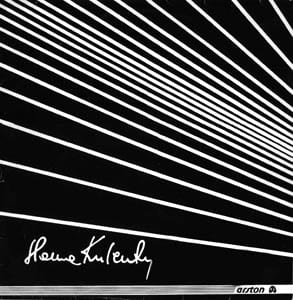
“An arch is simply a structure of a defined emotional course, of a defined climate, containing a climax. At the same time, an arch does not have to follow a classical course – from the introductory phase, through the climax up to the last sounds. It may begin at any place, for example from the climax.
I like to write very much as if the work began from the middle, from the climax. Only later does everything fall into an order in which every arch has its own length, develops in its own way, and not at all simultaneously. This is exactly how both of my symphonies are constructed. […] A polyphony of arches is an overlapping of several arches, combined in such a way that the work as a whole will have the form of an arch. I also try to arrange the climaxes of particular arches in succession one after another, so that something like a permanent climax is formed.
I was consciously exploring these techniques in Sesto right after the performance of Ad unum. It was extremely important that I could hear my music, and because of this I wrote Sesto, Quarto, Quinto, Arci. However, later those arches of mine got into my blood and I stopped thinking about them. I simply sit down and write. Actually, already Ad unum was created from the beginning to the end without anything crossed out. The only change was that I rewrote the pencil version in ink. Today I write right away in ink. I am sure of what I do, of what I hear. Just in case, though, I begin writing a work by notating all arches on a card. I simply write about the whole work in words. But once a work exists, I don’t change it.”
[Kulenty, PWM brochure, 1990]
Trigon consist of three arches. The first one is formed by piano and orchestra chords, the second one – by a variety of glissandi in strings, harp and percussion, while the third arch is a spectrum of low bass sounds (percussion and bassoon, which are gradually accompanied by more and more instruments). Each arch has its own development. The climax of the first one has been shaped by a swift sequence of chords, which subsequently fade away. The first arch ends at the top point of the second one: the glissandi culminate in a heterophonic quick movement. The third arch begins at the highest point of the second arch, its entry is “flat” or “horizontal” in spatial terms; thus it does not overlap with the second arch, but rather branches out from it.
[Kulenty, notes on Trigon, Warsaw Autumn 1992]
Awards and Commissions
Awards
1985 European Young Composers’ Competition, organized by the European Cultural
Foundation, Amsterdam, Holland, Second Prize for Ad Unum
1987 Stanislaw Wyspianski Award, Second Class Award for lifetime achievement
1987 Young Composers’ Competition of the Polish Composers’ Union, Second Prize for Ride
1986-1989 Four Prizes in the Composers’ Competition of the Warsaw Branch of the Polish Composers’ Union
1986 First Prize for Quinto
1987 First Prize for Breathe
1988 Third Prize for Cannon
1989 Second Prize for aaa TRE
2003 First Prize at the International Rostrum of Composers organized by UNESCO, for Trumpet Concerto, premiered in 2003.
2008 ‘Preludium, Postludium and Psalm‘ Nominated for one of the ten best new Dutch compositions of 2007 from Toonzetters Dutch Composition Contest.
2009 ‘String Quartet No. 3‘ Nominated for one of the ten best new Dutch compositions of 2007 from Toonzetters Dutch Composition Contest.
Updated 6/24/2022
Commissions
String Quartet No. 1, commissioned by the Ministry of Culture and Arts, Poland, 1984
Arci for percussion solo, commissioned by Stanisław Skoczyński, 1986
Symphony No. 2 for large orchestra and mixed choir, to texts from Spinoza’s Ethics, commissioned by Sender Freies, Berlin, 1987
Perpetuus for chamber ensemble, commissioned by De Ereprijs Ensemble, Holland, 1989
Trigon for chamber orchestra, commissioned by Rotterdamse Kunststichting, 1989
Piano Concerto No. 1, commissioned by De Ereprijs Ensemble, with funds from Fonds voor de Scheppende Toonkunst, Holland, 1990
String Quartet No. 2, commissioned by the Ministry of Culture and Arts,Poland, 1990
Air for chamber ensemble, commissioned by Volharding Orchestra with funds from Amsterdamse Kunststichting, Holland, 1991
E for E for harpsichord, commissioned by the Ministry of Culture and Arts for Elisabeth Chojnacka, 1991
Violin Concerto No. 1, version for violin and chamber orchestra, commissioned by De Ereprijs Ensemble with funds from School of Dance CNDO, 1992
Passacaglia for chamber orchestra, commissioned by Tage der Zeitenossische Musik, Dresden, 1992
Violin Concerto No. 1, version for violin and large orchestra, supported with a scholarship from Fonds voor de Scheppende Toonkunst, 1993
A Cradle Song for Violin, cello and piano commissioned by Conservatory of Music in Arnhem, 1993
Still Life with a Cello for cello solo, commissioned by the Schleswig-Holstein Festival, 1993
Sinequan for cello solo with delay, sponsored by Fonds voor de Scheppende Toonkunst, 1993
Sinequan Forte A for amplified cello with delay and symphony orchestra, sponsored with a scholarship from Fonds voor de Scheppende Toonkunst, 1994
Sinequan Forte B for amplified cello with delay and chamber orchestra, commissioned by Radio Kamer Orkest, with funds from Fonds voor de Scheppende Toonkunst, 1994
Lysanxia for gamelan and tape, commissioned by Gending Ensemble, Utrecht, with funds from Fonds voor de Scheppende Toonkunst, 1994
Works supported with a scholarship from Fonds voor de Scheppende Toonkunst:
A Fourth Circle for violin (or viola, or cello) and piano, 1994
A Fifth Circle for alto flute and delay, commissioned by Carine Levine, 1994
A Sixth Circle for trumpet and piano, 1994-1995
Going Up 1 for violin and double bass, 1995
Going Up 2 for chamber orchestra, 1995
Violin Concerto No. 2 for violin and large orchestra, 1996
The Mother of Black-Winged Dreams, opera in one act, commissioned by Munich Biennale, 1995
Sierra for violin and cello, commissioned by Munich Biennale, 1996
Blattinus for saxophone quartet, commissioned by Sirinks Saxophone Quartet, with funds from the Fonds voor de Scheppende Toonkunst, 1996
Elfen, ballet music for ensemble, commissioned by Academy of Dance, ArhneArnhem funds from the Fonds voor de Scheppende Toonkunst, Holland, 1997
Waiting for… for voice, piano, sponsored with a scholarship from the Fonds voor de Scheppende Toonkunst, 1997
Certus for chamber orchestra, commissioned by ASKO Ensemble, with funds from the Fonds voor de Scheppende Toonkunst, 1997
Part One for orchestra, commissioned by Het Gelders Orkest, with funds from the Fonds voor de Scheppende Toonkunst, 1998
Strettofor flute, clarinet, cello and guitar, commissioned by Warsaw Autumn Festival, with funds from the Fonds voor de Scheppende Toonkunst, 1998
Rapidus for saxophone quartet, sponsored with a scholarship from the Fonds voor de Scheppende Toonkunst, 1998
Harmonium for harmonium solo, commissioned by Dirk Luijmes, with funds from the Fonds voor de Scheppende Toonkunst, 1999
MM-blues for two pianos and two percussions, commissioned by Polish Radio 2, Warsaw, with funds from the Fonds voor de Scheppende Toonkunst, 1999
Decimo for choir in six parts, commissioned by Arnhem Choir festival 2000, Holland, 2000
Symphony No. 3 for symphony orchestra, commissioned by Het Gelders Orkest, with funds from the Fonds voor de Scheppende Toonkunst, 2000
Drive Blues for piano, commissioned by Marcel Worms, with funds from the Fonds voor de Scheppende Toonkunst, 2000
Flute Concerto No. 1 for flute (amplified with optional delay) and chamber orchestra, commissioned by the Ereprijs with funds from the Fonds voor de Scheppende Toonkunst, 2001
Asjaawaa for mezzo-soprano, flute, harp, piano, percussion, electronics, commissioned by the ensemble WireWorks, with funds from the Fonds voor de Scheppende Toonkunst, 2001
Crossing Lines for violin, clarinet, piano, commissioned by Bavarian State Opera
Trumpet Concerto, commissioned by Polish Radio 2, with funds from the Fonds voor de Scheppende Toonkunst, 2002
Hoffmanniana, opera in two acts, to a libretto based on the last screen-play by Andrei Tarkovsky, commissioned by Theater zum Westichen Stadthirschen, Berlin, with funds from the Fonds voor de Scheppende Toonkunst, 2001-2003
Piano Concerto No. 3, for piano solo and chamber orchestra, commissioned by ensemble Ereprijs, with from the Fonds voor de Scheppende Toonkunst, 2003
Principal Publishers
PWM Edition (PWM)
Polskie Wydawnictwo Muzyczne
al. Krasińskiego 11a
31-111 Kraków, Poland
Tel/Fax: 48–12–822-01-74
E-mail: internet@pwm.com.pl
Distribution in North America (USA, Canada, Mexico) by Sole Agent of PWM:
Theodore Presser Company
Presser Place, Bryn Mawr
Pennsylvania 19010
Fax: 215/527 7841
Most works composed after 1994 published by Muziekgroep Nederland (Donemus):
Paulus Potterstraat 14
1071 CZ Amsterdam
The Netherlands
Phone: 31 (0) 20 305 89 00
Fax: 31 (0) 20 673 35 88
E-mail: info@muziekgroep.nl
Film & TV
For details about Hanna Kulenty’s Film and Television work, please reference Kulenty’s website: here
Selected Bibliography
For Bibliography, click here.
Catalogues, promotional brochures:
Hanna Kulenty PWM Edition (1990, 1992, 1993)
Hanna Kulenty Donemus (2003)
Theses:
Cordula Jasper: Zur asthetik der musikalishen form bei Werken fur Schlagzeug solo M.A. thesis, Technische Universitat, Berlin 1996 (with analysis of Arci)
Articles:
Ługowska, Marta: A typical woman. Conversation with Hanna Kulenty Polish Music/Polnische Musik 24 no. 4 (1989): 16-23.
Padding,Martin: Essay in the Program Booklet of the Music Festival of Young Generation Composers Confrontaties Rotterdam 1989
Rasmussen, Per Erland: Gentlemen, hear and tremble!’ Komponisten Hanna Kulenty in Program Book of New Music Festival Musikhost 94, ed. P.E. Rasmussen, Odense, Denmark: Fyns Unge Tonekunstnerselskab, 1994
Solińska, Ewa: Article in Zycie Warszawy, 1992
Other interviews:
with Marietta Morawska-Bungeler (Cologne), Beata Stylińska (Warsaw, Polskie Radio), Volke Rabe (Swedish Radio),
Cordula Jasper (Zersplitterte Gefuhle: Ein Portrait der Polnischen Komponistin Hanna Kulenty; SFB Radio, Berlin, 1996)
Selected reviews from Poland:
Jan Weber (Życie Warszawy 1986, no. 223), Bohdan Pociej (Ruch Muzyczny 1988, no. 19; 1989 no. 14),
Elżbieta Szczepańska (Ruch Muzyczny October 1995)
Links
Kulenty at USC
Composer’s official website
Page updated 24 June 2022
